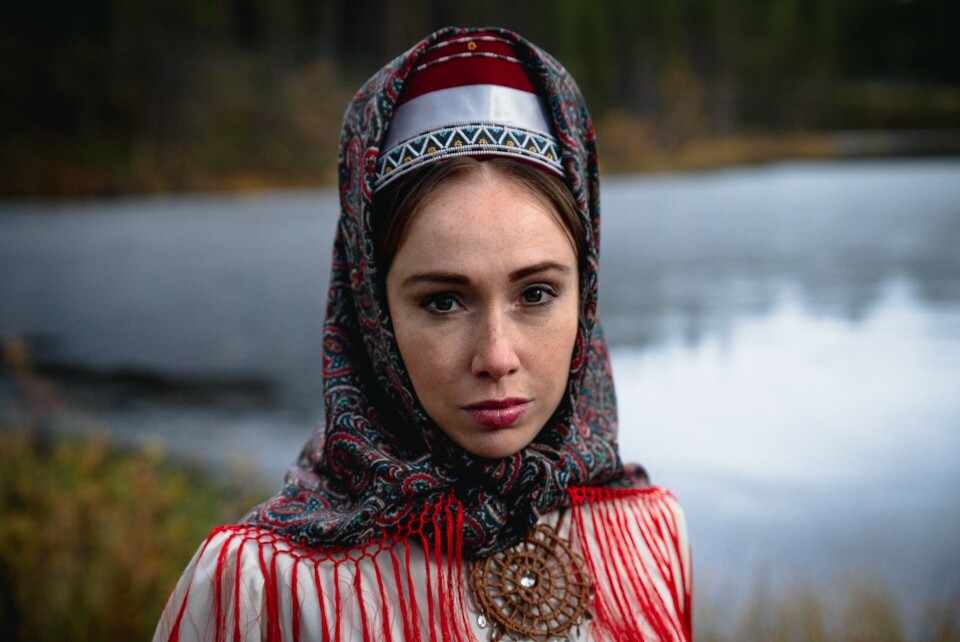
Wearing my pride
The bright red main cloth has been embroidered with beads of different colors.
p.p1 {margin: 0.0px 0.0px 13.0px 0.0px; line-height: 15.0px; font: 13.0px Helvetica; color: #333333; -webkit-text-stroke: #333333}span.s1 {font-kerning: none}
p.p1 {margin: 0.0px 0.0px 0.0px 0.0px; line-height: 23.0px; font: 19.3px Arial; color: #000000; -webkit-text-stroke: #000000; background-color: #ffffff}span.s1 {font-kerning: none}Text by Sara Wesslin, Yle Sápmi
Photos by Henry Lämsä, Yle
Technical realization by Antti Hämäläinen, Yle
The headdress of a Skolt Sámi woman tells a great deal more about the wearer than an untrained eye catches at first glance. The hat will reveal the marital status of the woman. Is she married or widowed, or maybe looking for a spouse?
According to an old tradition, the suitor will tie the satin bands of a Skolt Sámi maiden’s hat in a knot after finding a promising companion. It is a sign for the folks of the maiden to start planning a wedding.
Jasmin Semenoff, 18, from the village of Sevettijärvi, Finland, laughs softly at the story.
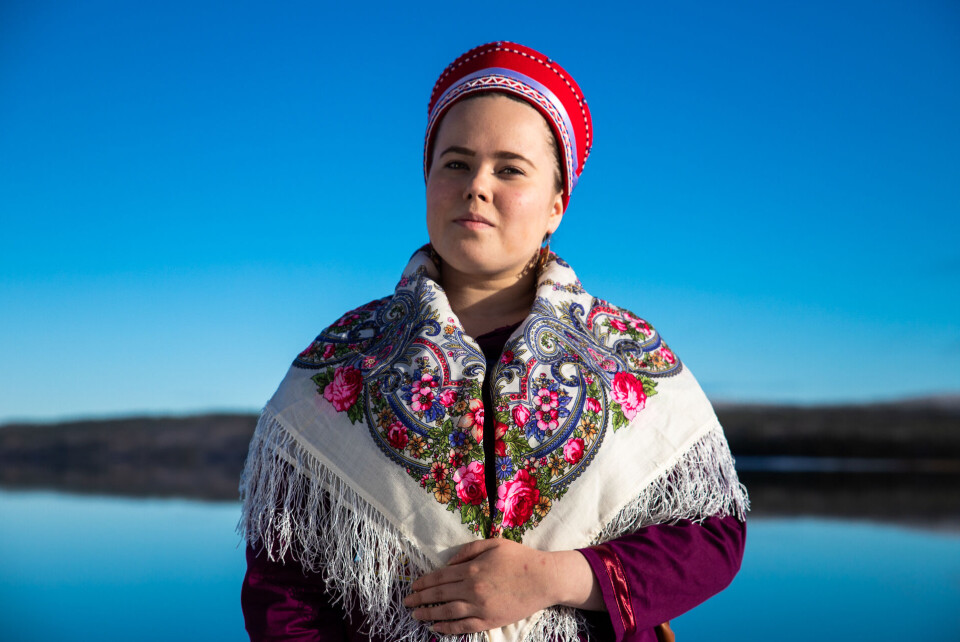
«I guess it might be true, but you don’t do that anymore,» she says.
The young woman dresses in her Skolt Sámi attire, and she has obviously done so many times.
The first things she puts on are the reindeer leather shoes. She wraps the yellow and red woolen laces around her ankles. Then she slips into the purple skirt that extends to her ankles. The hem waves as a result of dozens of folds. On top of the skirt, she wears a shirt, kuurta, which is also rich in folds.
The attire is topped off with the two garments that Semenoff considers the most beautiful ones. First, she carefully adjusts the fiery red maiden’s hat, peeʹrvesǩ, on her hairline. A beadwork belt gives a finishing touch to her posture.
«I get this great feeling when I dress up in the traditional clothing. I also feel proud.»
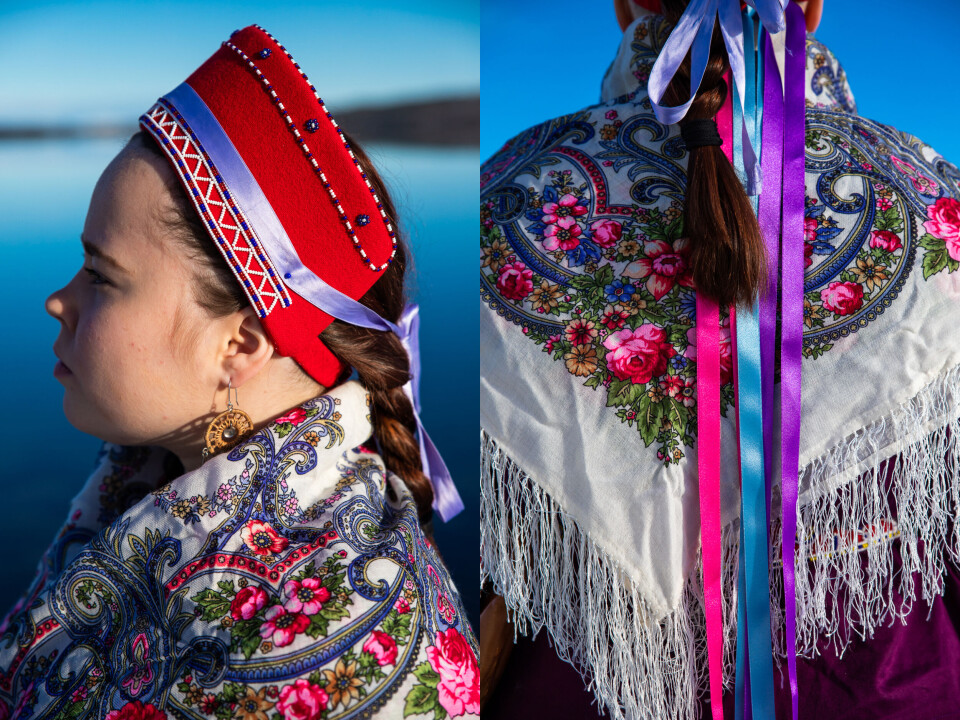
The peeʹrvesǩ is more modest than the hat of a married woman: the colorful satin bands end up floating behind under the hair. Almost naturally, the headdress makes a Skolt Sámi girl straighten herself up.
The Skolt Sámi dress is the most beautiful thing that she owns.
However, proud is not the word that Semenoff would use when describing her relationship to her Skolt Sámi roots.
She believes that wearing the Skolt Sámi attire did not feel the same for her parents as for her. It was by no way easy to be proud of being Sámi decades ago, but, for Skolt Sámi, the situation was even worse.
The Skolt Sámi are an indigenous people. They are one ethnic group among the Sámi. The traditional home region of the Skolt Sámi is situated in the border region of Finland, Norway and Russia. The number of Skolt Sámi in Finland is estimated to be six hundred. With only a few hundred speakers, the Skolt Sámi language is severely endangered.
As recently as 2006, the youngest native speaker of Skolt Sámi was over thirty years old.
The Skolt Sámi had to leave their traditional home region in Petchenga after World War II.
In 1949–1952, the Skolt Sámi settled in their new home regions in the municipality of Inari in Finland. In accordance with the final settling plan, the Skolt Sámi from Pechenga were settled in the neighborhood of Nellim, those from the Paatsjoki region in Keväjärvi, and the Skolt Sámi from Suonikylä in the region of Näätämö.
The Skolt Sámi are a minority within a minority, and they used to be considered an inferior Sámi group among the other Sámi groups.

You will have your native attire on at special occasions, from your christening to your funeral. Your family will see to it that you wear the dress correctly and erect.
A few decades ago, having a Sámi background was not appreciated. It was easier to hide your roots than to show that you belonged to a minority.
However, Jasmin Semenoff belongs to a generation that was taught in the Skolt Sámi language as early as at the elementary school.
The small girl gnashed her teeth when she studied the language of her family. Skolt Sámi was not spoken at her home, and, in a bigger village, the lessons of a small language felt like a burden for the young girl.
«More than anything else, learning Skolt Sámi was connected with shame, and I didn’t want to learn it. But when we moved to Sevettijärvi,» everything changed.

When the Semenoff family moved to Sevettijärvi, a Skolt Sámi village of two hundred inhabitants, Jasmin became interested in her native language. There were several pupils in her class studying Skolt Sámi, so she no longer had to study it alone. Skolt Sámi culture also played a big role in the teaching provided by the school.
Sámi handicrafts and the traditional clothing are the most visible part of indigenous culture. The traditional outfits are colorful and look like their wearers. The Sámi dress is always a whole with personal characteristics.
At present, the clothing tradition is vital and reflects the world as it is today. Usually, Sámi learn to dress in their native attire gradually, from early on.
To learn to wear a Skolt Sámi dress is not as simple.
Though we do see more and more Skolt Sámi dresses worn every year, many Skolt Sámi do not get their first traditional attire until they are almost adults.
Skolt Sámi women particularly have began to wear the traditional clothing more often.
Today, there is a variety of cotton fabrics used for skirts and shirts, rich in patterns and colors. Sewing a Skolt Sámi dress, määccaǩ, of your own inspires you to experiment. This strengthens your identity.

The Skolt Sámi clothing is, at best, like a continuation of one’s skin. It is like roots that tell where the wearer comes from and which line he or she belongs to.
Kati Ljetoff, 32, from Inari wore the Skolt Sámi outfit for the first time just two years ago.
She did not learn much about the Skolt Sámi clothing tradition until she started to study Sámi crafts and arts.
«It feels heavy to wear the Skolt Sámi dress. And I don’t mean this in a negative sense, but because it’s a totally new thing for me,» Ljetoff reflects.
Wearing the native Skolt Sámi attire has given Ljetoff a sense of belonging together with the other Sámi, but also having a connection to her own roots. In her family, almost nobody has ever worn the Skolt Sámi outfit.
When already an adult, Ljetoff realized that she kept being interested in Skolt Sámi crafts and arts. Eventually, she started studying to become an artisan in handicrafts.
The headdress of a married woman is the crown of Skolt Sámi handicrafts: the šaamsiǩ is as if made for goddesses.
«Now that I’m older I’ve finally understood where I belong. My native dress has played a big role in this. I want it to become even a stronger part of me,» Ljetoff says enthusiastically.
The Skolt Sámi clothing is very different from the other Sámi attires in Finland: the outfit is made of two parts and characterized by beadwork decorations and various headdresses.
There are less than ten people who know how to make Skolt Sámi handicrafts. For example, there is only one person who knows how to craft the impressive hat of a married woman, the šaamsiǩ.
In order to revive the tradition, the Sámi Handicrafts Association Sámi Duodji got a group of craftswomen together to learn to make this hat from the beginning to the end in early 2018. The teacher was an experienced craftswoman – the only one who had made such a hat for herself.

Ljetoff was one of the five participants of the course. Being a craftswoman, she feels a pressure to revive Skolt Sámi culture.
The headdress of a married woman is more impressive than the hats of a widow and a maiden. In other respects, it has the same style: bright red main fabric and beadwork decorations.
In times past, the horn-like shape of the hat was created with birch bark. At present, the bottom of the hat, the stiff part, is made from an old felt boot. It can take months even for the best and the most experienced artisans just to make this stiff part. The part is worked by hand, seam by seam, until it gets the final horn-like form.
The concave upper part of the hat bends around the woman’s face, reminding us of a horn. The hat is richer in beadwork than any other Sámi handicrafts.
«I crave to do a good job in making a married woman’s hat. I really want to succeed with it. In future, I’ll be one of those who know how to craft this headdress,» Ljetoff reflects.
Wearing her native dress for the first time felt extremely exciting for Heidi Gauriloff, 30. Settling the maiden’s hat on her head made her hands shake.
In dressing in the attire, she was assisted by her Skolt Sámi language teacher. Ever since a child, Gauriloff had looked forward to this moment: she had completed a year of studies in the Skolt Sámi language.
«The moment was the culmination of my year of language studies. My dress crowned my situation. I had finally learned to speak Skolt Sámi.»
The moment also inspired Gauriloff to get first the degree of an artisan and then complete an apprentice course in Skolt Sámi crafts. In Gauriloff’s line, no-one wore the Skolt Sámi dress anymore. Reviving the clothing tradition began to play a big role in her life and livelihood.
An experienced craftswoman taught Heidi Gauriloff how to do beadwork, sew a maiden’s hat and make patterns for a kuurta, a shirt rich in folds.
«I didn’t have anyone who could show or teach me what to do,» Gauriloff explains.
Gauriloff also ended up on the revitalization course where Kati Ljetoff, too, studied how to make a married woman’s hat.
«The course was really important for us. Making the married woman’s hat is a challenge, because only few of the older skilled craftswomen have made it,» Heidi Gauriloff says.
At present, the Sámi dress – gákti in North Sámi, mááccuh in Inari Sámi or määccaǩ in Skolt Sámi – can now be found in many forms: it can be an impressive celebration dress, but also a festival outfit or a practical everyday dress.
Jasmin Semenoff from Sevettijärvi wore her native dress for the first time at the upper level of compulsory schooling.
Before that, she had borrowed old Skolt Sámi clothes from the Sevettijärvi School or performed in other borrowed clothes.
The teenager did not like the feeling of wearing fusty, used clothes.
When Semenoff finally was able to put on a native dress of her own, she was all smiles. Soon, her dress became for her a way of showing her roots. Jasmin’s dress is entirely purple. It is her favorite color.
The dress is exactly the kind of dress that she can wear with pride.
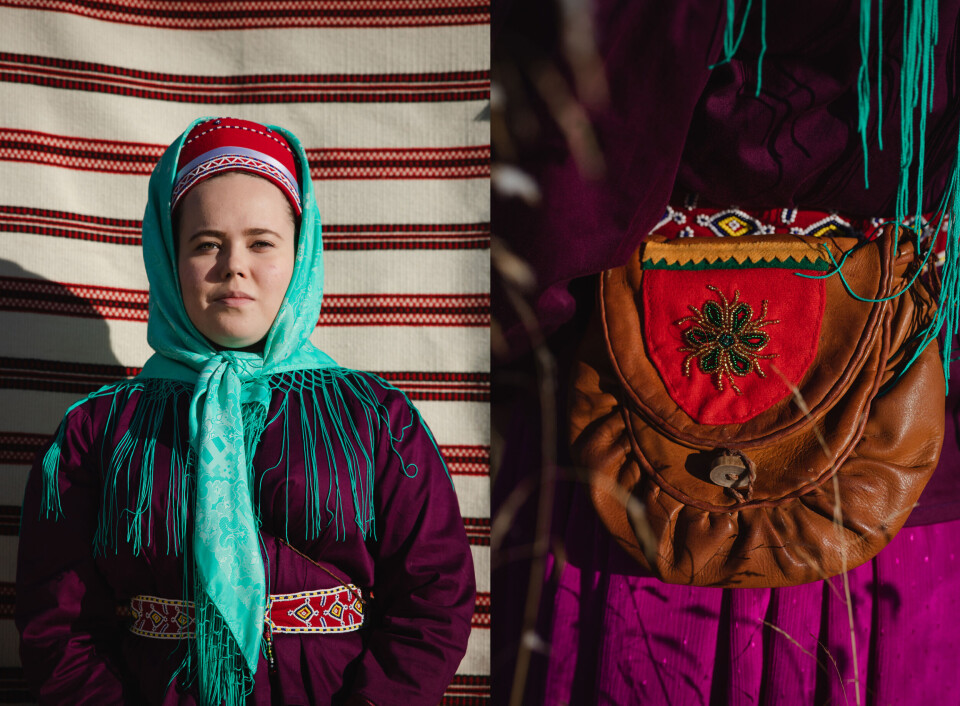
«Earlier, we Skolt Sámi were often called “Russians”. Things are different now. Today, we are mostly considered equal, especially among us Sámi young people,» Semenoff says.
Wearing the Skolt Sámi attire evokes diverse feelings both in the wearer and in the Sámi community. Often, older Skolt Sámi do not like the way the traditional clothing is worn today.
There is a certain threshold connected with wearing the Skolt Sámi dress. As a result of criticism against attempts to renew the traditional clothing, young people may even avoid wearing the outfit.
As the older generation have been ashamed of everything connected with Skolt Sámi culture and, thus, of themselves, they may feel frightened by the courage of the younger Skolt Sámi. They may even consider it strange. “That dress is not the right kind of dress; it’s not the kind that we used to wear.” “We couldn’t afford to use so many different colors in the old days.”
A young Skolt Sámi woman wears the dress as herself, wanting to show where she comes from. We did not see such feelings of pride even in the 1990s.
At present, the native dress represents much more positive feelings and experiences.
Ever after a Skolt Sámi wears the traditional clothing for the first time, he or she will feel and carry along looks that date from decades back. Glances that feel like a burden. In the old days, being Skolt Sámi was not something you took pride in, while it can be a source of pride today.
When you look at yourself in the mirror, wearing the native dress, you will face deep thoughts. Can I wear this clothing, though I never spoke Skolt Sámi in my childhood and adolescence? I hope I will not have to hear any negative comments on my dress.
The hardest thing is to be, after decades of shame, among the first ones to wear the clothing that will reveal one’s Skolt Sámi roots.
Heidi Gauriloff says that, in addition to excitement, she also felt ill when she wore the dress for the first time. The bad feeling was completely caused by other people’s opinions.
«When you wear the Sámi clothing, you’ll be sure to face criticism. Is the dress the way it should be? How have you put it on?»
There is an attempt to hang on to handicraft traditions for dear life.
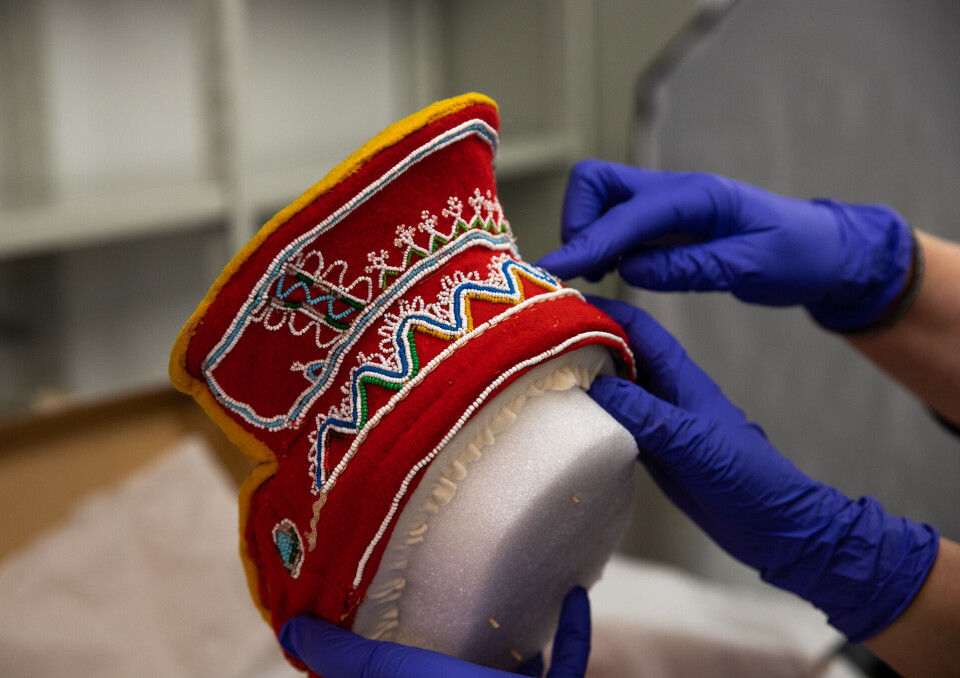
«In a way, our clothing tradition is still in a box. It seems that the older generation would like to lock that box,» Gauriloff describes.
As a craftswoman, Gauriloff is afraid that if no room is made, for example, for new colors, the whole handicraft tradition will become something for museums only.
«I wish we could take delight in every person who wears the traditional clothing and all new craftspeople,» Gauriloff says.
In their work, the young artisans would like to focus on providing support and information to those who are younger than they are. For those who consider making a Skolt Sámi dress for themselves, Kati Ljetoff has a clear message: her dress has only strengthened her self-esteem.
«I’m happy about the way in which I have grown as a person, and a traditional dress of my own has contributed to this growth. For me, the native dress is now the best outfit I have – and the strongest part of myself,» Kati Ljetoff reflects.
In Ljetoff’s opinion, the Skolt Sámi clothing should reflect the time in which the Sámi live, not just the past. In future, young Skolt Sámi will have many examples who will show that you do not need to be afraid of expressing your roots.
I wish everyone would feel, deep inside, the zeal to take pride in wearing the native dress.
«We Skolt Sámi should reflect on whether we will keep on carrying the burden of shame. I think it is time to let go.”
Jasmin Semenoff swears that, one day, she will be able to make every part of the dress on her own. Trying something new does not mean that she would ignore the traditions.
«For me, Skolt Sámi culture is something that I want to pass down to others. When I get a family of my own, I want my children to wear the Skolt Sámi dress and to learn the language. And one day, I will have the courage to speak the language.»
Translated from Finnish by Kaija Anttonen
This story is originally posted by Yle Sapmi and re-published as part of Eyes on Barents, a collaborative partnership between news organizations and bloggers in the Barents region















